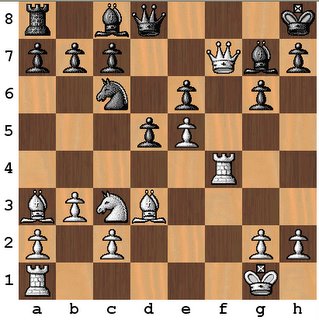Pattern "recognition" run amok
Tonight I blew a game I would have taken easily if I didn't suck. I was up a rook against an opponent who played coin flip chess on most moves (see the Heisman article on Real Chess to the right). I was in complete control. Or so I thought. I am white, and just captured his rook with my queen:
 At this point, I am pumped: I just grabbed a major piece, I am deep in enemy territory, and I "recognize" a pattern from the Chess Tutor. Namely, I see the potential to get his h pawn out of the way and mate with my rook on h4. I sacrifice my white bishop, pulling his pawn out of the way ("Oh, I'll deal with the fact that his queen can take on h4 later, using my g pawn as protection," I foolishly thought).
At this point, I am pumped: I just grabbed a major piece, I am deep in enemy territory, and I "recognize" a pattern from the Chess Tutor. Namely, I see the potential to get his h pawn out of the way and mate with my rook on h4. I sacrifice my white bishop, pulling his pawn out of the way ("Oh, I'll deal with the fact that his queen can take on h4 later, using my g pawn as protection," I foolishly thought).
Yes, I know my move (Bxg6) was stupid. It wasn't long before I lost the game. I'm lucky I didn't wake my wife yelling at myself for my stupidity.
Pattern recognition is great, but now that I have built up a tiny bit of it, I have started to get lazy in my calculations. Note to self: while you may recognize certain aspects of a pattern, it is most likely not the exact same pattern. While it is exciting to see a pattern like one I learned while doing the circles (hell, it would be nice if all this training started to actually pay off!), I need to relax, take a deep breath, and think through the most likely variations. Very subtle differences in patterns (and not so subtle, as in the above) have radical affects on play.
For some reason I feel I should move faster in the end game because the board is so much more "simple" than during the middle game. I have learned, with the Chess Tutor, that even king-pawn endgames are not particularly simple, so I should have no shame when I need to take some time to think. Hell, why should I bother seeking 20/20 games when I end up with 12 minutes on my clock at the end?!
 At this point, I am pumped: I just grabbed a major piece, I am deep in enemy territory, and I "recognize" a pattern from the Chess Tutor. Namely, I see the potential to get his h pawn out of the way and mate with my rook on h4. I sacrifice my white bishop, pulling his pawn out of the way ("Oh, I'll deal with the fact that his queen can take on h4 later, using my g pawn as protection," I foolishly thought).
At this point, I am pumped: I just grabbed a major piece, I am deep in enemy territory, and I "recognize" a pattern from the Chess Tutor. Namely, I see the potential to get his h pawn out of the way and mate with my rook on h4. I sacrifice my white bishop, pulling his pawn out of the way ("Oh, I'll deal with the fact that his queen can take on h4 later, using my g pawn as protection," I foolishly thought).Yes, I know my move (Bxg6) was stupid. It wasn't long before I lost the game. I'm lucky I didn't wake my wife yelling at myself for my stupidity.
Pattern recognition is great, but now that I have built up a tiny bit of it, I have started to get lazy in my calculations. Note to self: while you may recognize certain aspects of a pattern, it is most likely not the exact same pattern. While it is exciting to see a pattern like one I learned while doing the circles (hell, it would be nice if all this training started to actually pay off!), I need to relax, take a deep breath, and think through the most likely variations. Very subtle differences in patterns (and not so subtle, as in the above) have radical affects on play.
For some reason I feel I should move faster in the end game because the board is so much more "simple" than during the middle game. I have learned, with the Chess Tutor, that even king-pawn endgames are not particularly simple, so I should have no shame when I need to take some time to think. Hell, why should I bother seeking 20/20 games when I end up with 12 minutes on my clock at the end?!


